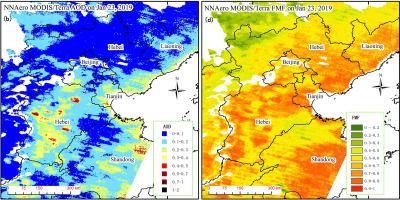当前位置:
X-MOL 学术
›
Remote Sens. Environ.
›
论文详情
Our official English website, www.x-mol.net, welcomes your feedback! (Note: you will need to create a separate account there.)
Joint retrieval of the aerosol fine mode fraction and optical depth using MODIS spectral reflectance over northern and eastern China: Artificial neural network method
Remote Sensing of Environment ( IF 13.5 ) Pub Date : 2020-11-01 , DOI: 10.1016/j.rse.2020.112006 Xingfeng Chen , Gerrit de Leeuw , Antti Arola , Shumin Liu , Yang Liu , Zhengqiang Li , Kainan Zhang
Remote Sensing of Environment ( IF 13.5 ) Pub Date : 2020-11-01 , DOI: 10.1016/j.rse.2020.112006 Xingfeng Chen , Gerrit de Leeuw , Antti Arola , Shumin Liu , Yang Liu , Zhengqiang Li , Kainan Zhang

|
Abstract The Fine Mode Fraction (FMF) of atmospheric aerosol is very important for environment and climate studies. Attempts have been made to retrieve the FMF from satellite data with varying success. In this work, the development of an artificial Neural Network for AEROsol retrieval (NNAero) is presented. NNAero uses data from the NASA MODerate resolution Imaging Spectroradiometer (MODIS) flying on the NASA Terra and Aqua satellites. The MODIS-derived spectral reflectances of solar radiation at the top of the atmosphere (TOA) and at the surface were used together with ground-based Aerosol Robotic Network (AERONET) measurements of Aerosol Optical Depth (AOD) and FMF to train a Convolutional Neural Network (CNN) for the joint retrieval of FMF and AOD. The NNAero results over northern and eastern China were validated against an independent reference AERONET dataset (i.e. not used in training the CNN). The results show that 68% of the NNAero AOD values are within the MODIS expected error (EE) envelope over land of ±(0.05 + 15%), which is similar to the results from the MODIS Deep Blue (DB) algorithm (63% within EE), and both are better than the Dark Target (DT) algorithm (31% within EE). The validation of the NNAero FMF vs AERONET data shows a significant improvement with respect to the DT FMF, with Root Mean Squared Prediction Errors (RMSE) of 0.1567 (NNAero) and 0.34 (DT). The NNAero method shows the potential of improved retrieval of the FMF.
更新日期:2020-11-01



























 京公网安备 11010802027423号
京公网安备 11010802027423号